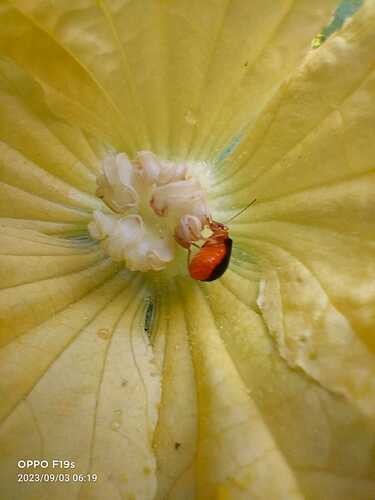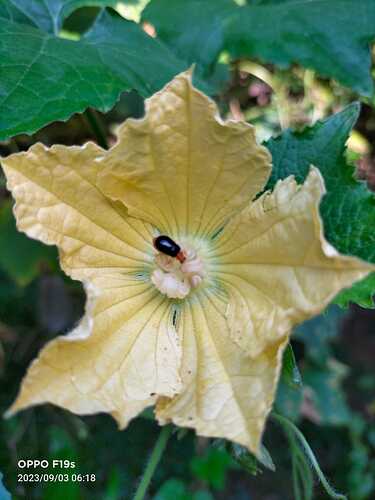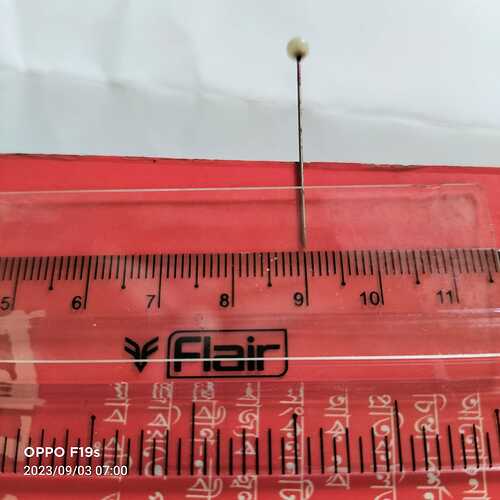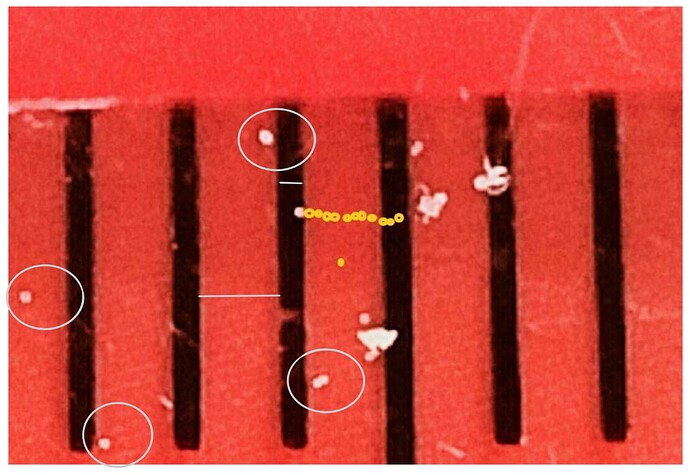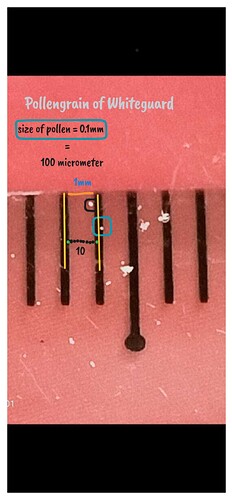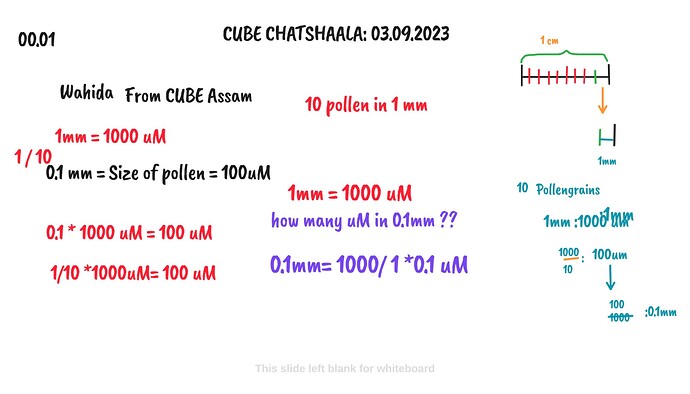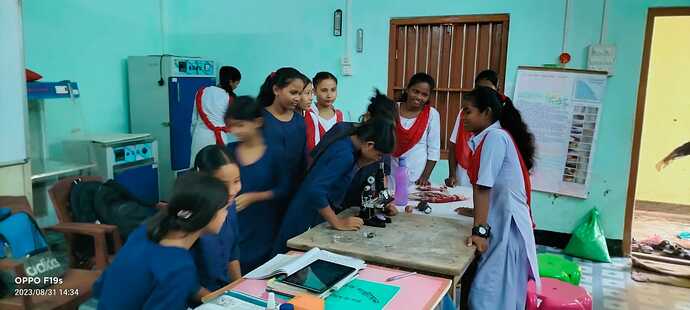In yesterday’s (4/09/2023)Chatshaala, we encountered difficulty in measuring the size of pollen grains using a scale, not because of the scale, but because of our confusion between millimeters and micrometers.
It wasn’t just a single person who had this confusion, the majority of us faced this issue @Shraddha276 @shalinisharma98 @lakshmy @KhushiGupta .
Communication collaboration Continuity
Cubists are asking questions to themselves and communicate with other Cubists and getting them as collaborators, An example shown below @Susanta_Tanti from CUBE Sapekhati taken an interesting initiative to measure the size of Pollengrains using Mobile Phone.
Post made By @Susanta_Tanti on Context to Curriculum Whatsapp Group
Pollengrains where collected from White Gourd flower.
Accepeted challenge (Task )![]() for pollen photography using Mobile Camera
for pollen photography using Mobile Camera
Today I take white gourd male flower available at home garden lab.
Size of pollen ~50 micron.
Materials used for photography:
- Red book cover ( for color contrast)
- Scale to show mm size.
- Needle to remove pollen from flower.
- Mobile phone as camera.
- Microscope for microphotograph.
Photographs follows:
Setting before photography : The slide with pollen was kept on a needle and scale to compare size.
Highlights of Yesterdays Chatshaala Disscussion
A photo shows a pollen grain on a 15cm scale.
Within the 15cm scale, there are 15 divisions, each with a length of 1cm.
A picture depicts a pollen grain in between 1mm.
What is the actual size of that pollen?
How many such pollen grains can be arranged in a 1mm space?
We attempted to mark 10 pollen grains within a 1mm portion and @magpie mentioned that if we divide 1mm into 10 equal parts, it should be 100 µm.
Cubists became confused at this point, wondering how that could be @Shraddha276 @KhushiGupta @lakshmy
Confusions are came there like ,how can we convert mm to µm,want to divide or multiply !!
In between instead of millimeter ,milli molar also came in discussion ![]()
![]() .
.
How mm and mM different !? @Shraddha276
During our later discussion, we attempted to understand the basics behind this.
How many pollen grains can fit in 1mm?
Here, we have drawn 10 pollen grains in 1mm.
As we know:
1m = 100cm,
1cm = 10mm,
and 1mm = 1000µm.
From that, we can deduce:
1mm is equivalent to 1000µm.
In our case, we had 10 pollen grains in 1000µm.
So, 1000/10 = 0.1mm. 0.1mm x 1000 = 100µm.
Therefore, the size of 1 pollen grain is 100µm.
Any questions? @Shraddha276 @KhushiGupta @04872621705 @shalinisharma98 @Himanshu @KiranKalakotiR & others
@Susanta_Tanti says According to a reference, the size of a pollen grain of white gourd is said to be 50µm.
Let’s all try taking photographs of pollen grains using our mobile cameras and study and understand the basic mathematics involved.
How are we reached Pollen Photography as a Context to understand the Biology and Mathematics !!!
Glimpses of Whatsapp group Discussions
As we know CUBE National meet was help on 22nd &23rd of July 2023 at Somaiya College Mumbai. .Susanta sir and 2 student from CUBE Sapekhati joined us with in Offline at Somaiya College ,Mumbai .
Later Susanta sir introduced CUBE activities to His students at CUBE Sapekhati.
Causery : Seed germination and classification of plants into Dicot and monocots at CUBE Sapekhati, Assam . New comers to cube lab of grade 8 to 12. Date: 30th August, 2023. Photo: Priyanka
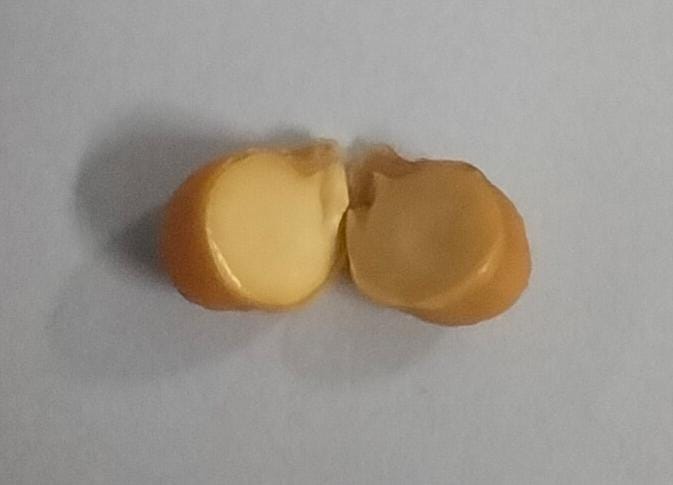
Class 11 students are new comer to SCHOOL so they are new to CUBE LAB too. Today we have started a new session of seed germination with gram seeds. 5 nos of water soaked gram seeds are kept in a petridish with a soaked tissue paper in it to support the seeds with water for germination.
Time 2.30 PM 30/8/2023.
They are asked to observe after 24 hrs and record the germination status.
Photo : a half open gram seed to show plumule.
Collaborators of Cube School Lab :
Himakshi
Rodali
Priyanka
Anjali
Sweety
Gitashree
Seed germination study got disrupted by a rat😰 । All the seeds kept on petridish was eaten !
But students practising use of nicroscope with onion cells and pollen grains.
[02/09, 6:16 pm] Arunan sir: Can’t pollen grains be studied using mobile camera?
Can you post some pictures of pollen grains taken using mobile bile camera, by your student collaborators? @Susanta Tanti CUBE
Let’s give this as a challenge. @Susanta Tanti CUBE
[02/09, 6:19 pm] Susanta Tanti CUBE: ![]() pollen grain with mobile . No idea sir . The pollen grains are so tiny that could not seen with camera but seen like a powder indeed.
pollen grain with mobile . No idea sir . The pollen grains are so tiny that could not seen with camera but seen like a powder indeed.
[02/09, 6:25 pm] Arunan sir: How tiny is pollen grain? Any reference on the range of size of pollen grains? @Susanta Tanti CUBE
[02/09, 6:27 pm] Arunan sir: “Angiosperm pollen grain diameter varies greatly from a few microns to over 100, but the selective forces driving the interspecific variation in pollen size remain unclear.”
https://royalsocietypublishing.org/doi/10.1098/rspb.2020.1191#:~:text=Angiosperm%20pollen%20grain%20diameter%20varies%20greatly%20from%20a%20few%20microns%20to%20over%20100%2C%20but%20the%20selective%20forces%20driving%20the%20interspecific%20variation%20in%20pollen%20size%20remain%20unclear.
[02/09, 6:28 pm] Arunan sir: Can we take photos of objects of about 100 microns using Mobile camera and a ruler?
[02/09, 6:30 pm] Susanta Tanti CUBE: May be .![]() Will try tomorrow to take photos and post.
Will try tomorrow to take photos and post.
[02/09, 6:32 pm] Arunan sir: ![]() @Susanta Tanti CUBE Let’s capture pollen of Hibiscus flower using Mobile camera.
@Susanta Tanti CUBE Let’s capture pollen of Hibiscus flower using Mobile camera.
Let’s use a clean background and good lighting.
A great opportunity to know what is the relationship between one millimeter and 100 micron.![]()
![]() @Theertha @Kiran di @Susanta Tanti CUBE @Dhanraj CUBE @Sakshi @Sunitha Mam and others.
@Theertha @Kiran di @Susanta Tanti CUBE @Dhanraj CUBE @Sakshi @Sunitha Mam and others.
